Type of resources
Available actions
Topics
Keywords
Contact for the resource
Provided by
Formats
Representation types
Update frequencies
status
Scale
-
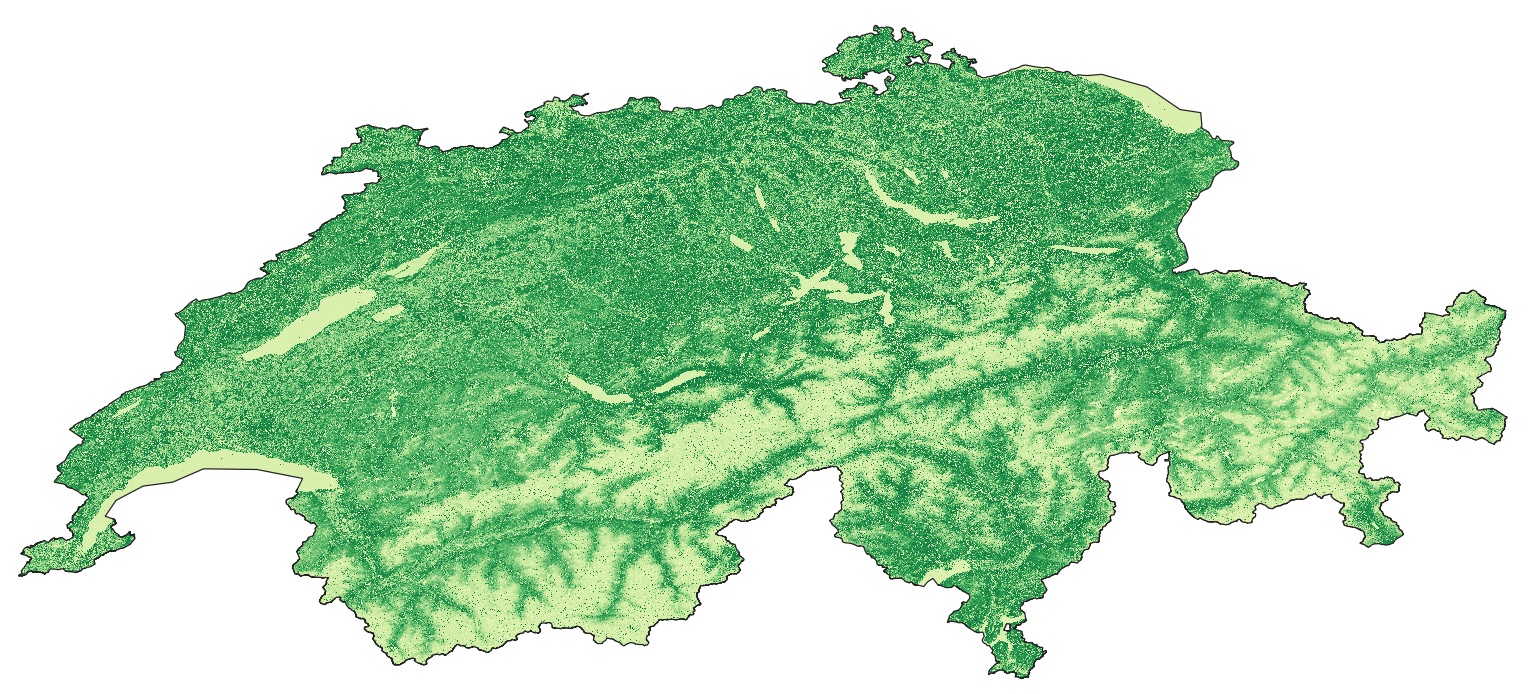
This dataset is an time-serie of Sentinel-2 Analysis Ready Data (ARD)- derived Leaf Area Index (LAI) computed from Sentinel-2 data. LAI is designed to analyze the foliage surface of our planet and it estimates the quantity of leaves in a specific region using the forumla LAI= 3.618*EVI - 0.118. For more details see Boegh et al. (2002) DOI: 10.1016/S0034-4257(01)00342-X LAI is a unitless measure that is calculated as the ratio of the one-sided (illuminated) foliage area to the soil surface it can cover. This vegetation index is important to monitor crop and forest health, the environment, and climatic conditions. Values are provided as integer and multiplied by 1000 Metrics: annual (_annual) and seasonal (_spring; _summer; _autumn; _winter) mean (_nanmean), standard dev (_nanstd), min (_nanmin), max (_nanmax), median (_nanmedian), and amplitude (_range) Data format: GeoTiff
-

This dataset is the Landsat 7 Analysis Ready Data (ARD) - Level 2 (surface reflectance) archive for Switzerland. Detailed description about the Landsat 7 mission can be found in the CEOS Earth Observation Handbook: http://database.eohandbook.com/database/missionsummary.aspx?missionID=349 The Landsat archive is extremely interesting because this is the longest EO program, initiated in 1972, it has provided continual and consistent observations for almost 50 years. Since 2008, the complete data archive has been provided under a free and open access policy. This has enabled dense time-series analysis, moving beyond simple diachronic comparison of a set of images, therefore dramatically improving capabilities to monitor environmental changes. To cover the whole of Switzerland, it requires eight Landsat 7 scenes (Path/Row: 193/027, 194/027, 195/027, 196/027, 193/028, 194/028, 195/028, 196/028) representing an area of latitude 44.9 to 48.7 and longitude 4.1 to 12.8. Data are downloaded as Collection 1/Tier 1 – Level 2 Surface Reflectance encompassing a surface of approximately 185km by 180km. Collection 1/Tier 1 scenes are data with the highest available data quality (e.g., geometric and radiometric corrections) and considered suitable for time-series analysis (https://www.usgs.gov/land-resources/nli/landsat/landsat-collection-1). Level 2 corresponds to surface reflectance (i.e., the estimate based on Landsat sensor observations of the fraction of incoming solar radiation reflected from Earth’s surface). These data are corrected for atmospheric perturbations (e.g., aerosol scattering, thin clouds) enabling direct comparison between multiple images and dates. This corresponds to the ARD level. The sensor’s Scan-Line Corrector (SLC) failed in July 2003 and approximately 225 of the pixels per scene have since then not been scanned. However, the spatial and spectral quality of the remaining 78% of pixels images remain valid. Landsat data are provided by USGS with Quality Assessment (QA) information to help users to determine their suitability for specific applications. An 8-bit LandsatLook Quality Image and 16-bit Quality Assessment Band40 are also included. Details on each file are described at: https://www.usgs.gov/land-resources/nli/landsat/landsat-collection-1-level-1-quality-assessment-band. Level 2 products are generated by the USGS from level 1 product and using the official LEDAPS/LASRC algorithm. "A Pixel Quality Assurance (pixel_qa) band is provided with all Landsat Surface Reflectance-derived Spectral Indices. The band is in unsigned 16-bit format, values are bit-packed and provide information pertaining to a pixel condition of fill, clear, water, cloud shadow, snow, cloud (yes/no), cloud confidence and cirrus cloud confidence (Landsat 8 only)" https://www.usgs.gov/land-resources/nli/landsat/landsat-sr-derived-spectral-indices-pixel-quality-band.
-
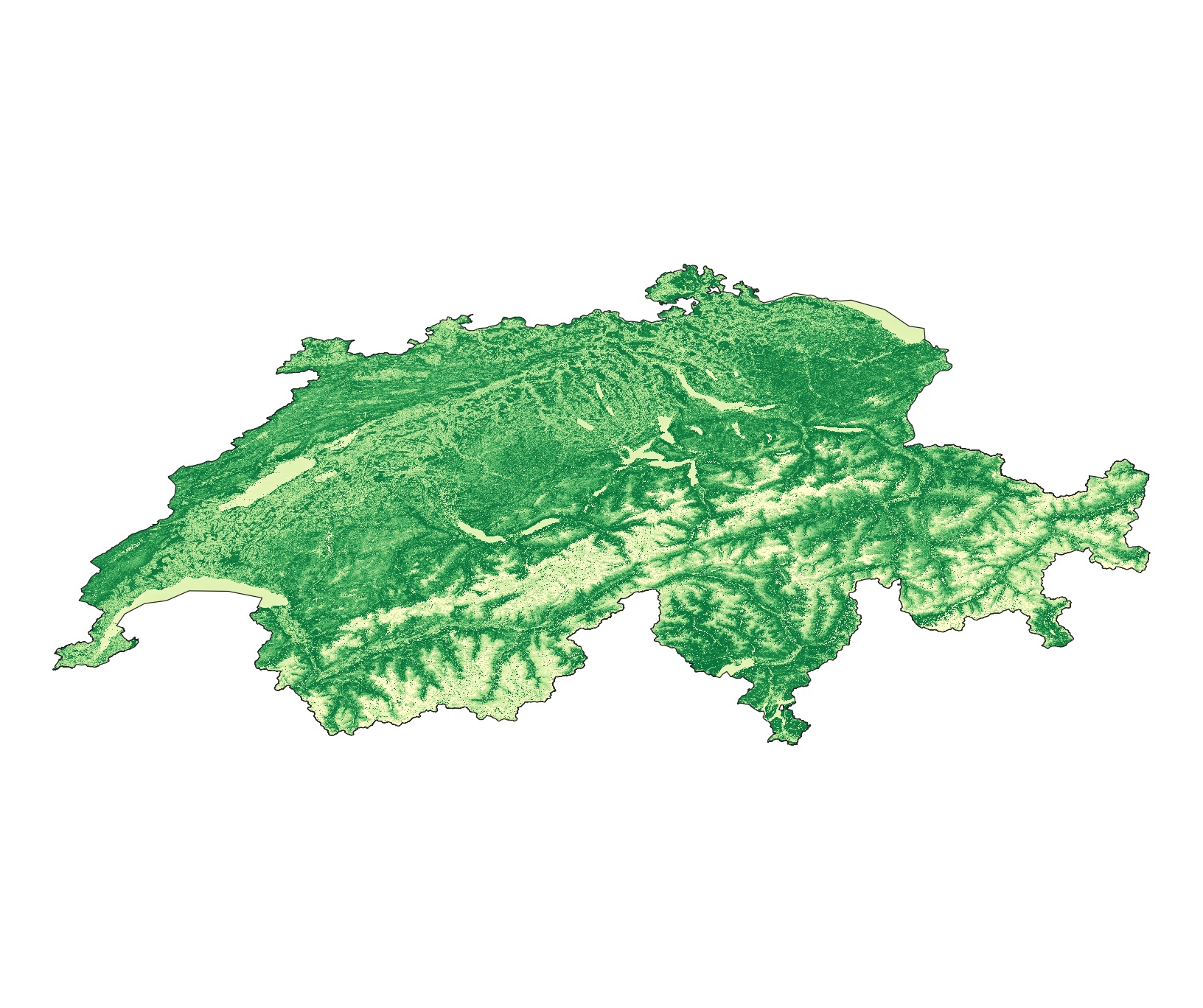
This dataset is an time-serie of Landsat Analysis Ready Data (ARD)- derived Leaf Area Index (LAI) computed from Landsat 5-7-8 data. LAI is designed to analyze the foliage surface of our planet and it estimates the quantity of leaves in a specific region using the forumla LAI= 3.618*EVI - 0.118. For more details see Boegh et al. (2002) DOI: 10.1016/S0034-4257(01)00342-X LAI is a unitless measure that is calculated as the ratio of the one-sided (illuminated) foliage area to the soil surface it can cover. This vegetation index is important to monitor crop and forest health, the environment, and climatic conditions. Values are provided as integer and multiplied by 1000 Metrics: annual (_annual) and seasonal (_spring; _summer; _autumn; _winter) mean (_nanmean), standard dev (_nanstd), min (_nanmin), max (_nanmax), median (_nanmedian), and amplitude (_range) Data format: GeoTiff
-
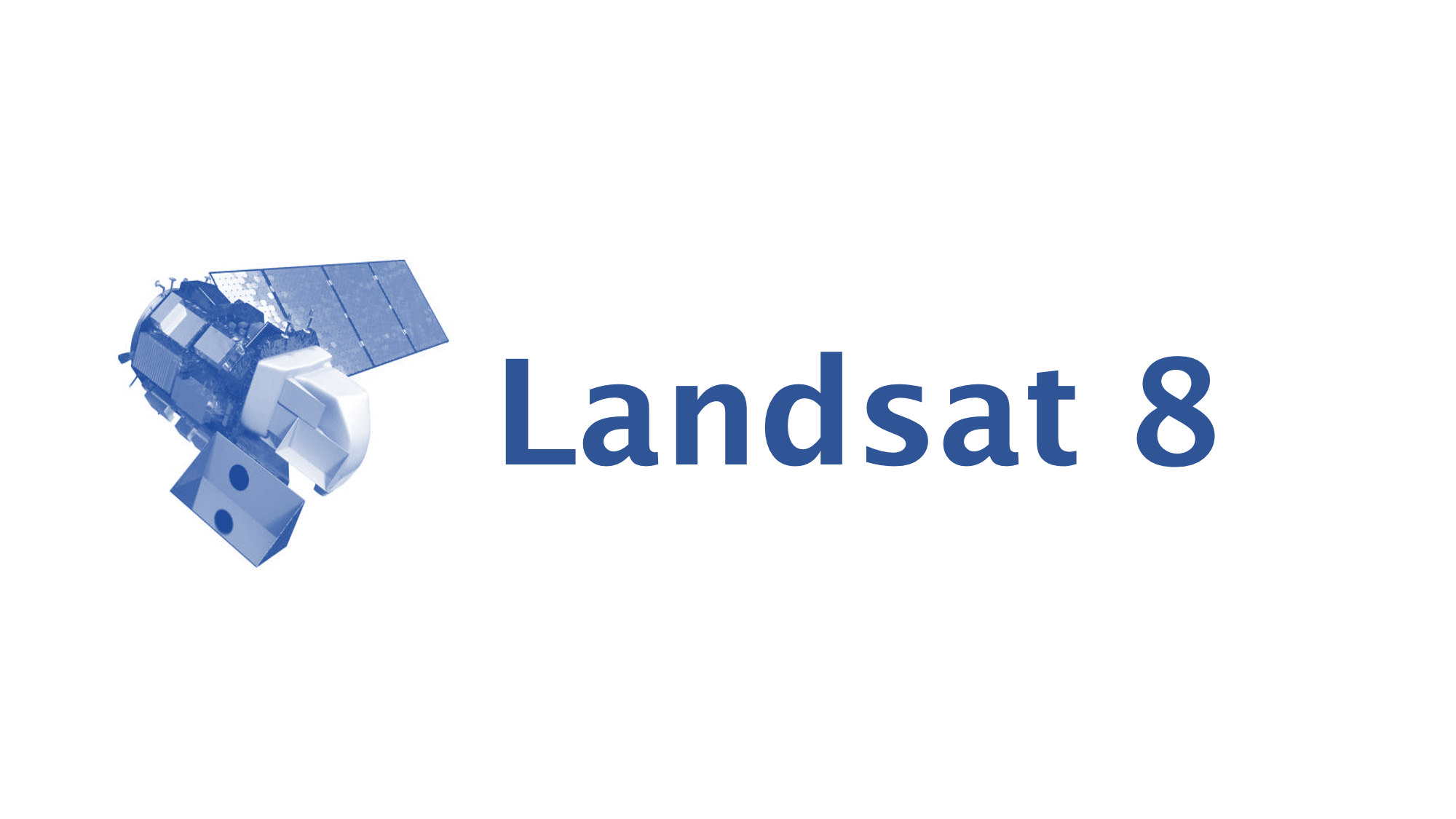
This dataset is the Landsat 5 Analysis Ready Data (ARD) - Level 2 (surface reflectance) archive for Switzerland. Detailed description about the Landsat 8 mission can be found in the CEOS Earth Observation Handbook: http://database.eohandbook.com/database/missionsummary.aspx?missionID=547 The Landsat archive is extremely interesting because this is the longest EO program, initiated in 1972, it has provided continual and consistent observations for almost 50 years. Since 2008, the complete data archive has been provided under a free and open access policy. This has enabled dense time-series analysis, moving beyond simple diachronic comparison of a set of images, therefore dramatically improving capabilities to monitor environmental changes. To cover the whole of Switzerland, it requires eight Landsat 8 scenes (Path/Row: 193/027, 194/027, 195/027, 196/027, 193/028, 194/028, 195/028, 196/028) representing an area of latitude 44.9 to 48.7 and longitude 4.1 to 12.8. Data are downloaded as Collection 1/Tier 1 – Level 2 Surface Reflectance encompassing a surface of approximately 185km by 180km. Collection 1/Tier 1 scenes are data with the highest available data quality (e.g., geometric and radiometric corrections) and considered suitable for time-series analysis (https://www.usgs.gov/land-resources/nli/landsat/landsat-collection-1). Level 2 corresponds to surface reflectance (i.e., the estimate based on Landsat sensor observations of the fraction of incoming solar radiation reflected from Earth’s surface). These data are corrected for atmospheric perturbations (e.g., aerosol scattering, thin clouds) enabling direct comparison between multiple images and dates. This corresponds to the ARD level. Landsat data are provided by USGS with Quality Assessment (QA) information to help users to determine their suitability for specific applications. An 8-bit LandsatLook Quality Image and 16-bit Quality Assessment Band40 are also included. Details on each file are described at: https://www.usgs.gov/land-resources/nli/landsat/landsat-collection-1-level-1-quality-assessment-band. Level 2 products are generated by the USGS from level 1 product and using the official LEDAPS/LASRC algorithm. "A Pixel Quality Assurance (pixel_qa) band is provided with all Landsat Surface Reflectance-derived Spectral Indices. The band is in unsigned 16-bit format, values are bit-packed and provide information pertaining to a pixel condition of fill, clear, water, cloud shadow, snow, cloud (yes/no), cloud confidence and cirrus cloud confidence (Landsat 8 only)" https://www.usgs.gov/land-resources/nli/landsat/landsat-sr-derived-spectral-indices-pixel-quality-band.
-

This dataset is the Sentinel-2 Analysis Ready Data (ARD) - Level 2 (surface reflectance) archive for Switzerland. Detailed description about the Sentinel-2 missions can be found in the CEOS Earth Observation Handbook: Sentinel-2 A http://database.eohandbook.com/database/missionsummary.aspx?missionID=552 and Sentinel-2 B http://database.eohandbook.com/database/missionsummary.aspx?missionID=553. Switzerland is covered by twelve Sentinel-2 scenes (ID: 31TGM, 31TGN, 32TLR, 32TLS, 32TLT, 32TMR, 32TMS, 32TMT, 32TNS, 32TNT, 32TPS, 32TPT). This corresponds to a spatial extent of latitude 45.0 to 47.9N, longitude 5.5 to 11.8E. Data are downloaded as L1C products corresponding to 100x100km2 geometrically corrected Top Of the Atmosphere (TOA) tiles. Atmospheric corrections are applied to generate normalized surface reflectance that correspond to the ARD level (i.e., Level 2A). For that, we use the ESA Sen2Cor algorithm (http://step.esa.int/main/third-party-plugins-2/sen2cor/)38 version 2.5.5 (2.8.0 version is not used as it is not able to process products before 2017). The algorithm follows two steps to pre-process data: first, it executes an image classification to identify and generate masks of clouds, cloud shadows, snow and water. Second, it applies an atmospheric correction model to convert TOA values into surface reflectance. Sen2Cor provides additional outputs on Aerosol Optical Thickness (AOT) and Water Vapour (WV). In the S2 ARD workflow, all bands are pre-processed and ingested except the band 10 that is only used for atmospheric corrections and consequently not relevant for users. It is important to mention that topographic correction is not applied as it creates strong artefacts. Sentinel-2 processed to level 2A with Sen2Cor comes with a scene classification (similar to the pixel_qa band provided by USGS for Landsat data) with 12 classes as described at: https://earth.esa.int/web/sentinel/technical-guides/sentinel-2-msi/level-2a/algorithm. It helps identifying pixels that are saturated or defective as well as cloud and cloud shadows that may affect the quality of the images. In addition, ESA provides a monthly status of the quality of Sentinel-2 data through Data Quality Reports (DQR). These reports document geometric and radiometric performances against initial sensor specifications together with observed anomalies and issues. DQR are available at: https://sentinels.copernicus.eu/web/sentinel/data-product-quality-reports.
-
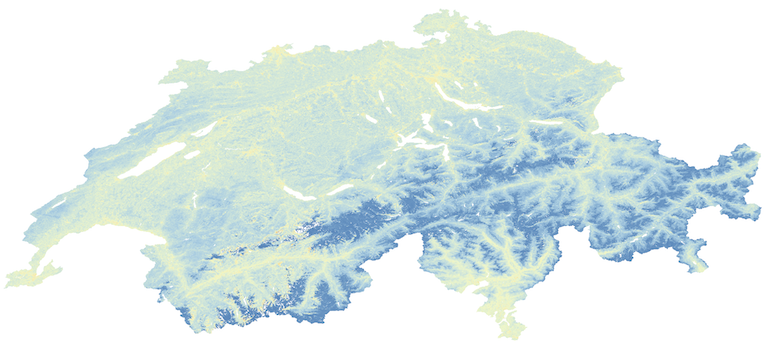
This dataset is an annual time-serie of Landsat Analysis Ready Data (ARD)-derived Normalized Difference Water Index (NDWI) computed from Landsat 5 Thematic Mapper (TM) and Landsat 8 Opeational Land Imager (OLI). To ensure a consistent dataset, Landsat 7 has not been used because the Scan Line Correct (SLC) failure creates gaps into the data. NDWI quantifies plant water content by measuring the difference between Near-Infrared (NIR) and Short Wave Infrared (SWIR) (or Green) channels using this generic formula: (NIR - SWIR) / (NIR + SWIR) For Landsat sensors, this corresponds to the following bands: Landsat 5, NDVI = (Band 4 – Band 2) / (Band 4 + Band 2). Landsat 8, NDVI = (Band 5 – Band 3) / (Band 5 + Band 3). NDWI values ranges from -1 to +1. NDWI is a good proxy for plant water stress and therefore useful for drought monitoring and early warning. NDWI is sometimes alos refered as Normalized Difference Moisture Index (NDMI) Standard Deviation is also provided for each time step. Data format: GeoTiff This dataset has been genereated with the Swiss Data Cube (http://www.swissdatacube.ch)
-

This dataset is the Landsat 5 Analysis Ready Data (ARD) - Level 2 (surface reflectance) archive for Switzerland. Detailed description about the Landsat 5 mission can be found in the CEOS Earth Observation Handbook: http://database.eohandbook.com/database/missionsummary.aspx?missionID=226 The Landsat archive is extremely interesting because this is the longest EO program, initiated in 1972, it has provided continual and consistent observations for almost 50 years. Since 2008, the complete data archive has been provided under a free and open access policy. This has enabled dense time-series analysis, moving beyond simple diachronic comparison of a set of images, therefore dramatically improving capabilities to monitor environmental changes. To cover the whole of Switzerland, it requires eight Landsat 5 scenes (Path/Row: 193/027, 194/027, 195/027, 196/027, 193/028, 194/028, 195/028, 196/028) representing an area of latitude 44.9 to 48.7 and longitude 4.1 to 12.8. Data are downloaded as Collection 1/Tier 1 – Level 2 Surface Reflectance encompassing a surface of approximately 185km by 180km. Collection 1/Tier 1 scenes are data with the highest available data quality (e.g., geometric and radiometric corrections) and considered suitable for time-series analysis (https://www.usgs.gov/land-resources/nli/landsat/landsat-collection-1). Level 2 corresponds to surface reflectance (i.e., the estimate based on Landsat sensor observations of the fraction of incoming solar radiation reflected from Earth’s surface). These data are corrected for atmospheric perturbations (e.g., aerosol scattering, thin clouds) enabling direct comparison between multiple images and dates. This corresponds to the ARD level. Landsat data are provided by USGS with Quality Assessment (QA) information to help users to determine their suitability for specific applications. An 8-bit LandsatLook Quality Image and 16-bit Quality Assessment Band40 are also included. Details on each file are described at: https://www.usgs.gov/land-resources/nli/landsat/landsat-collection-1-level-1-quality-assessment-band. Level 2 products are generated by the USGS from level 1 product and using the official LEDAPS/LASRC algorithm. "A Pixel Quality Assurance (pixel_qa) band is provided with all Landsat Surface Reflectance-derived Spectral Indices. The band is in unsigned 16-bit format, values are bit-packed and provide information pertaining to a pixel condition of fill, clear, water, cloud shadow, snow, cloud (yes/no), cloud confidence and cirrus cloud confidence (Landsat 8 only)" https://www.usgs.gov/land-resources/nli/landsat/landsat-sr-derived-spectral-indices-pixel-quality-band.
-

This dataset is the Sentinel-1 Analysis Ready Data (ARD) archive for Switzerland. Detailed description about the Sentinel-1 missions can be found in the CEOS Earth Observation Handbook: Sentinel-1A (http://database.eohandbook.com/database/missionsummary.aspx?missionID=575) and Sentinel-1B (http://database.eohandbook.com/database/missionsummary.aspx?missionID=576). To produce Sentinel-1 Analysis Ready Radiometrically Terrain Corrected (RTC) products, ground range detected (GRD) products are downloaded from the EU scihub.copernicus.eu. A digital elevation model (DEM) is then used to generate an image simulation of the local contributing area within each image sample. That area is used to normalise the backscatter (rather than the ellipsoid model otherwise typically used) in ground range geometry. Then that normalized backscatter is terrain-geocoded (orthorectified) into the chosen map coordinates, producing a level-1 RTC product. Sets of multiple RTC products acquired from different orbit tracks within a tight temporal window are then combined using local resolution weighting into level-3 multitemporal backscatter composite products. The region covered is latitude 44.5 to 48.5N, longitude 5.5-11E, at 90m spatial resolution and 6 day temporal spacing. The geometry of Sentinel-1 data is well calibrated: data can be geocoded without any tiepoints to an accuracy of a few centimeters , far better than is possible with optical sensors. Sentinel-1 radiometric stability is monitored and calibrated within the Sentinel-1 Mission Performance Centre. A broad review of the quality of multiple implementations of radiometric terrain correction (RTC) processing was provided in. The quality of the terrain correction and radiometric corrections depends on the quality of the input DEM made available. Participants in the Copernicus programme (currently not including Switzerland) are able to access a world-wide high-quality DEM with 30m resolution, with 10m models available in some regions.
-
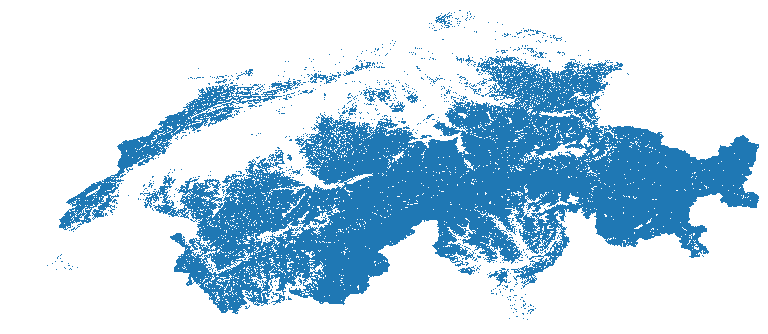
This dataset is a time-series of monthly snow cover maps over Switzerland computed from Landsat & Sentinel-2 Analysis Ready Data (ARD) for December 1984 to December 2021 These maps quantify the presence/absence of snow using the Snow Observation from Space algorithm developed by Poussin et al. in: https://doi.org/10.1016/j.srs.2023.100078 and in a submitted paper (Snow Observation from Space: An approach to map snow cover from four decades of Landsat and Sentinel-2 imageries across Switzerland). Snow cover is an Essential Climate Variables (ECV) playing a significant role in the climate system due to its high albedo and heat insulation. Snow cover also contributes to soil moisture and runoff, making it a crucial variable for monitoring climate change. Values ranges from 0 to 2. The monthly snow cover products have values ranging from 0 to 2 with the following classification for each pixel: • 0 when the pixel is snow-free (i.e., land), • 1 when the pixel is covered with snow, • 2 when the pixel is covered with clouds (including cloud shadow), • NA when the pixel is classified as water or lies outside of Switzerland. Data format: GeoTiff
-

This dataset is a seasonal time-series of Landsat Analysis Ready Data (ARD)-derived Normalized Difference Water Index (NDWI) computed from Landsat 5 Thematic Mapper (TM) and Landsat 8 Opeational Land Imager (OLI). To ensure a consistent dataset, Landsat 7 has not been used because the Scan Line Correct (SLC) failure creates gaps into the data. NDWI quantifies plant water content by measuring the difference between Near-Infrared (NIR) and Short Wave Infrared (SWIR) (or Green) channels using this generic formula: (NIR - SWIR) / (NIR + SWIR) For Landsat sensors, this corresponds to the following bands: Landsat 5, NDVI = (Band 4 – Band 2) / (Band 4 + Band 2). Landsat 8, NDVI = (Band 5 – Band 3) / (Band 5 + Band 3). NDWI values ranges from -1 to +1. NDWI is a good proxy for plant water stress and therefore useful for drought monitoring and early warning. NDWI is sometimes alos refered as Normalized Difference Moisture Index (NDMI) Standard Deviation is provided in a separate dataset for each time step. Spring: March-April_May (_MAM) Summer: June-July-August (_JJA) Autumn: September-October-November (_SON) Winter: December-January-February (_DJF) Data format: GeoTiff This dataset has been genereated with the Swiss Data Cube (http://www.swissdatacube.ch)
 SwissEnvEO
SwissEnvEO